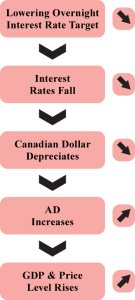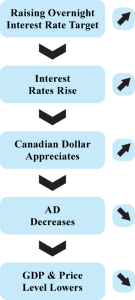10.6 The Overnight Rate and its Implications for the Economy
If the Bank of Canada (BoC) expects the economy to slow down, they would lower the overnight interest rate target and conduct an open market operation of SPRA. This lowers the prevailing market interest rates and increases the money supply. The value of the CAD decreases. Therefore, consumption and investment increase as borrowing cost lowers. Further, as CAD depreciates in value, exports increase relative to imports. As the components of the Aggregate demand ([latex]AD[/latex]) function increase, [latex]AD[/latex] increases, and this raises the price level. The BoC took this policy during 2020 and 2021 when the Canadian economy slowed down due to the Covid crisis. Look at the schematic fig 10.10 below that explains this policy of increasing money supply in the economy.

If the Bank of Canada expects the economy to experience rising prices or inflation, they would raise the overnight interest rate target and conduct an open market operation of SRA. This raises the prevailing market interest rates and decreases the money supply. The value of the CAD increases. Therefore, consumption and investment decrease as borrowing cost rises. Further, as CAD appreciates in value, exports decrease relative to imports. As the components of the Aggregate demand ([latex]AD[/latex]) function decrease, [latex]AD[/latex] decreases and this lowers the price level. This is the policy the Bank of Canada has adopted from the early months of 2022 in an attempt to control high inflation in Canada. The BoC attempts to cut spending in the economy to bring down prices through this policy that decreases money supply.
Look at schematic Fig 10.11 below.


